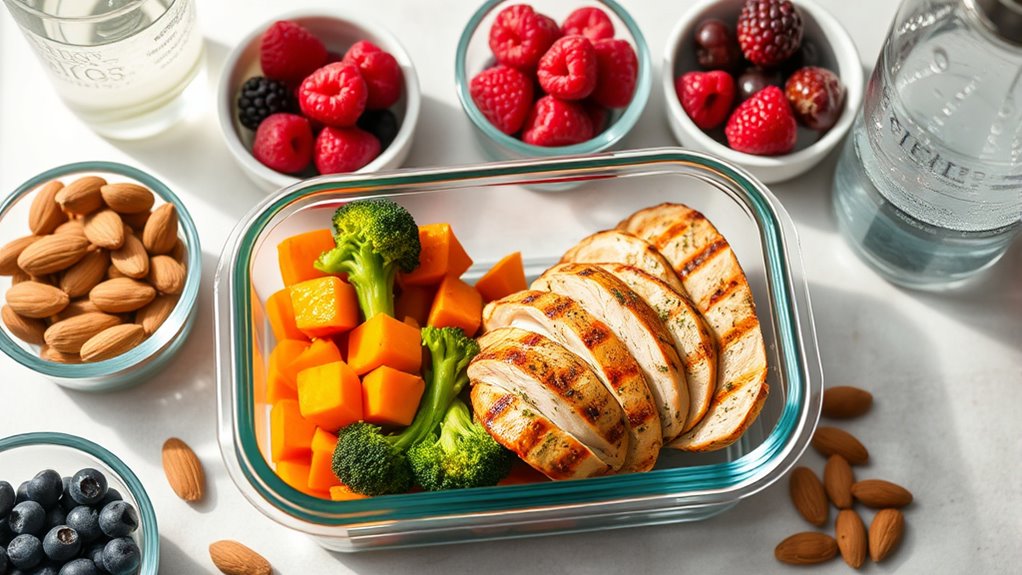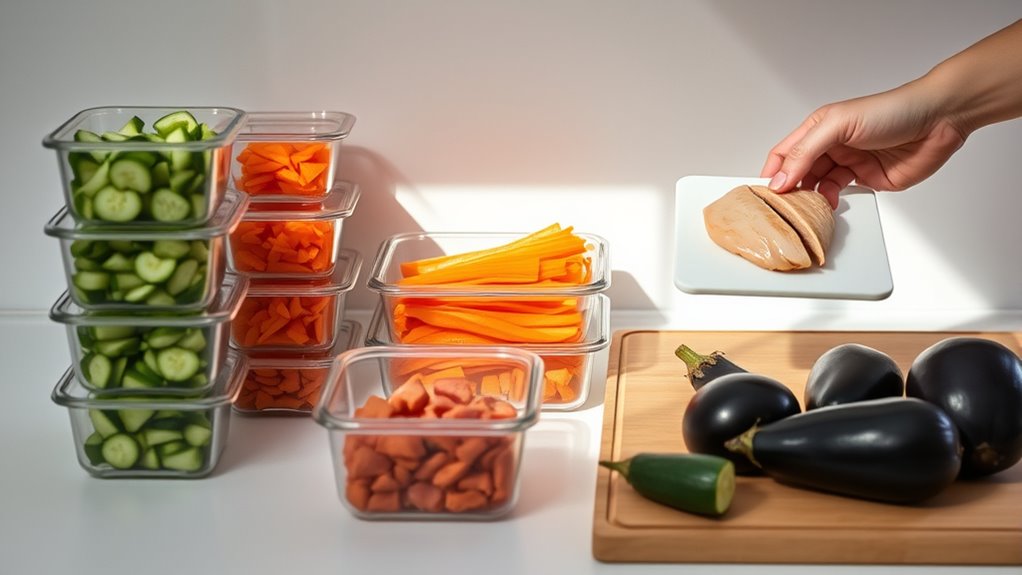Meal prepping for one helps you control portions, reduce waste, and enjoy nutritious meals tailored to your preferences. By measuring ingredients, using single-serving containers, and planning simple recipes, you can avoid leftovers and save money. Focus on scalable ingredients and versatile dishes that can be customized with different toppings or sauces. Practicing these strategies makes healthy eating easier and more enjoyable, and you’ll discover even more helpful tips as you continue exploring effective meal prep techniques.
Key Takeaways
- Plan weekly menus with recipes that easily divide into single-serving portions to prevent leftovers.
- Use small, divided containers for storing individual meals and snacks for grab-and-go convenience.
- Measure ingredients precisely during meal prep to control portion sizes and reduce food waste.
- Customize recipes with toppings or sauces for variety and to suit personal taste preferences.
- Focus on versatile ingredients like cooked proteins and grains that can be mixed and matched for different meals.

Have you ever wondered how to make meal prepping easier when you’re cooking just for yourself? It’s a common challenge—balancing the desire to eat healthy, save money, and avoid waste all at once. The good news is that mastering portion control and recipe customization can transform your solo prep routine into something simple and satisfying. When you focus on portion control, you prevent leftovers from piling up and ensure each meal is just right for your appetite. Instead of guessing or eyeballing portions, measure out ingredients or use containers that divide your food into single-serving sizes. This not only helps with calorie management but also makes it easier to plan your week without feeling overwhelmed or guilty about excess food.
Recipe customization is another key factor. When you’re cooking for just yourself, it’s tempting to make large, generic batches that don’t suit your tastes or dietary needs. Instead, tailor each meal to your preferences. If you love spicy food, add extra chili; if you prefer milder flavors, keep it simple. Customize recipes to match your nutritional goals—more veggies, lean proteins, or whole grains—so each meal is both enjoyable and aligned with your health objectives. This approach prevents food waste because you’re preparing exactly what you want to eat, reducing the likelihood of leftovers going bad or being thrown away.
Tailor each meal to your preferences to reduce waste and enjoy every bite.
To start, plan your weekly menu based on your schedule and cravings. Focus on one or two recipes that can be easily divided into individual portions—think wraps, salads, stir-fries, or grain bowls. Use small containers to portion out each meal, so you just grab and go. This way, you’re not cooking a huge batch of something that might not get eaten in time. Adjust each recipe as needed, maybe adding different toppings or sauces to keep things interesting throughout the week. You can also prepare versatile ingredients—cooked chicken, roasted vegetables, grains—that can be mixed and matched for variety without extra effort.
Additionally, understanding the importance of calorie control can help you make more mindful choices and prevent overeating. The key is to keep it simple and flexible. By controlling portions, you avoid waste and save money. With recipe customization, you ensure every meal hits the spot, making your solo meal prep both practical and enjoyable. The more you practice these strategies, the more natural it’ll become to whip up tasty, perfectly sized meals that suit your life. Meal prepping for one doesn’t have to be complicated; it just takes a little planning and a focus on your personal preferences.
Frequently Asked Questions
How Can I Meal Prep With Limited Kitchen Space?
When you have limited kitchen space, focus on using compact appliances and multi-purpose tools to maximize efficiency. Choose a small blender, a multi-functional slow cooker, or a compact microwave to prepare meals without clutter. Multi-purpose tools like a foldable cutting board or stackable storage containers help save space. By prioritizing versatile appliances and space-saving tools, you can meal prep effectively without overcrowding your small kitchen.
What Are Budget-Friendly Meal Prep Options for Singles?
Think of your kitchen as a small shop where you’re stocking only the essentials. For budget-friendly meal prep, focus on simple, versatile ingredients like beans, rice, and seasonal veggies. Use portion control to avoid waste and stretch your budget further. You’ll craft tasty, nutritious meals without overspending, turning your limited space into a smart, efficient pantry. With some planning, you’ll enjoy variety and savings in every meal.
How Do I Store Prepped Meals to Keep Them Fresh?
To keep your prepped meals fresh, focus on proper food storage. Use airtight containers to preserve flavor and prevent spoilage. Label each container with dates to track freshness and avoid waste. Store meals in the refrigerator for short-term freshness, and consider freezing portions for longer storage. Maintaining consistent temperature and avoiding overpacking helps preserve the quality of your food, ensuring it stays delicious and safe to eat.
What Are Quick and Easy Recipes for One Person?
Think of quick recipes as your personal express train—getting you from hungry to satisfied in no time. For single servings, try scrambled eggs with veggies, a simple stir-fry, or overnight oats. These meals are easy to prepare and perfect for busy days. With just a few ingredients, you can whip up delicious, healthy single servings that save time and reduce waste. Ready to make meal prep a breeze?
How Can I Customize Meal Prep for Dietary Restrictions?
You can customize your meal prep by selecting recipes that fit your dietary restrictions. Look for gluten-free options and incorporate vegan substitutions like plant-based proteins and dairy alternatives. Adjust ingredients to suit your needs, such as using gluten-free grains or adding more vegetables. Planning ahead helps you avoid waste and guarantees your meals align with your diet, making prepping easier and more enjoyable for you.
Conclusion
Think of meal prepping for one as tending a personal garden. With a little planning, you plant seeds of healthy choices, nurture them with your time, and harvest fresh, satisfying meals each week. Just like a garden flourishes with care, your habits grow stronger with each prep session, reducing waste and boosting your well-being. Embrace this routine as your own tasty oasis—where mindful tending leads to nourishment and enjoyment every day.









